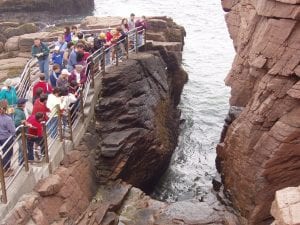Tourist Sound Analysis
Surveys of park visitors show that soundscapes are important to them, and research has found that scenery is more meaningful to people when there is less artificial noise. Lower noise levels also help visitors hear wildlife and naturally occurring sound. Park managers are responsible for making and implementing decisions about which sounds contribute to the park and which may hinder the visitor experience.  While natural sounds – such as waves breaking on the shore, the roar of a waterfall, or the call of the loon – form a valued part of the visitor experience, the sounds of motor vehicle traffic, an electric generator, or loud music can greatly diminish the serenity of the experience, the effectiveness of a park interpretive program, or the ability of a visitor to hear wildlife.
While natural sounds – such as waves breaking on the shore, the roar of a waterfall, or the call of the loon – form a valued part of the visitor experience, the sounds of motor vehicle traffic, an electric generator, or loud music can greatly diminish the serenity of the experience, the effectiveness of a park interpretive program, or the ability of a visitor to hear wildlife.
With dramatic increases in traffic, the explosion of digital gadgets, and our increasing capacity to reach once-remote areas, quiet solitude is a diminishing commodity. Not surprisingly then, the American public comes to parks with natural quiet in mind. In fact, 72% of Americans say one of the most important reasons for preserving national parks is to provide opportunities to experience natural peace and the sounds of nature.
 The 2017 WPI Tourist Sound Analysis Team will study the effects of human-caused noise on visitors, quantify current baseline noise levels at high visitor areas, capture and archive recordings, develop a Sound Standard for preserving the sonic integrity of the park, and devise a strategy for disseminating this information to the public. The Sound Standard would be a series of recommendations designed to set standards of quality that define acceptable conditions in the park. Furthermore, the Sound Standard would outline actions to be taken to target adverse sonic conditions as well as procedures and technologies effective at noise abatement. Once indicators and standards of quality have been formulated, indicator variables will be monitored to ensure that standards of quality are maintained.
The 2017 WPI Tourist Sound Analysis Team will study the effects of human-caused noise on visitors, quantify current baseline noise levels at high visitor areas, capture and archive recordings, develop a Sound Standard for preserving the sonic integrity of the park, and devise a strategy for disseminating this information to the public. The Sound Standard would be a series of recommendations designed to set standards of quality that define acceptable conditions in the park. Furthermore, the Sound Standard would outline actions to be taken to target adverse sonic conditions as well as procedures and technologies effective at noise abatement. Once indicators and standards of quality have been formulated, indicator variables will be monitored to ensure that standards of quality are maintained.


